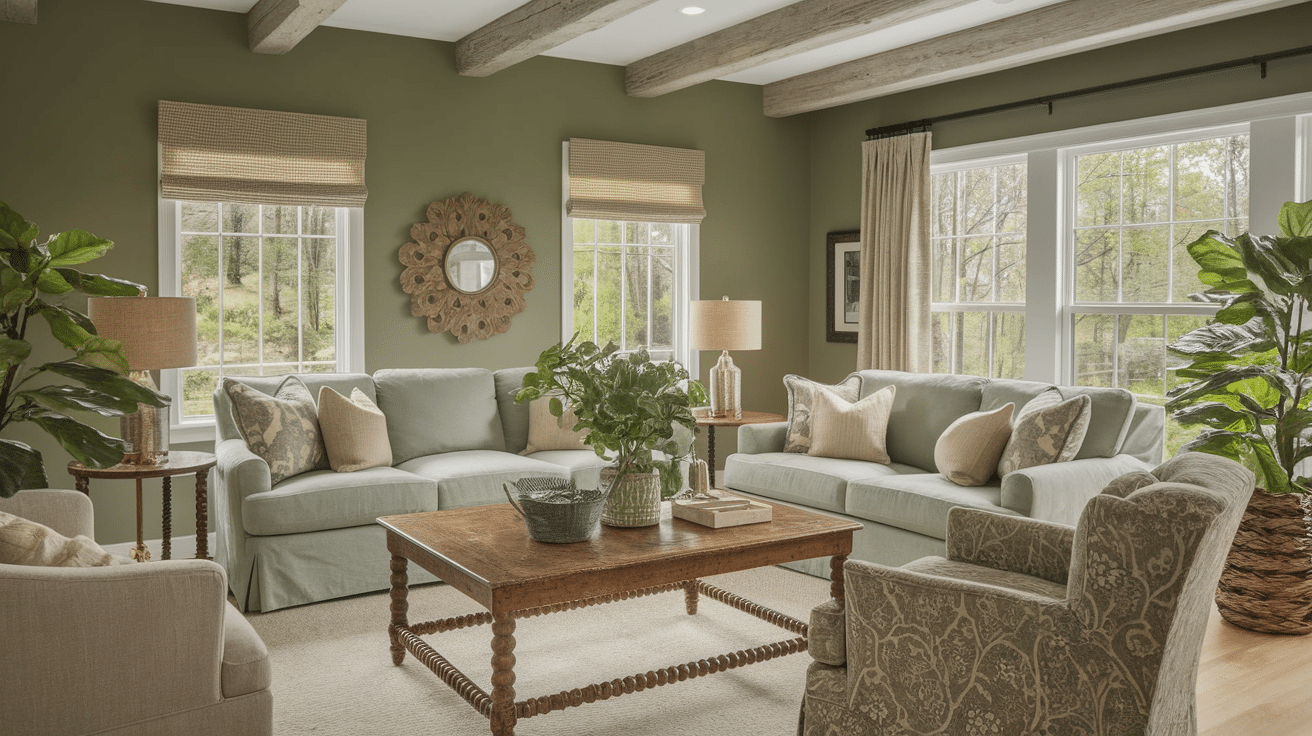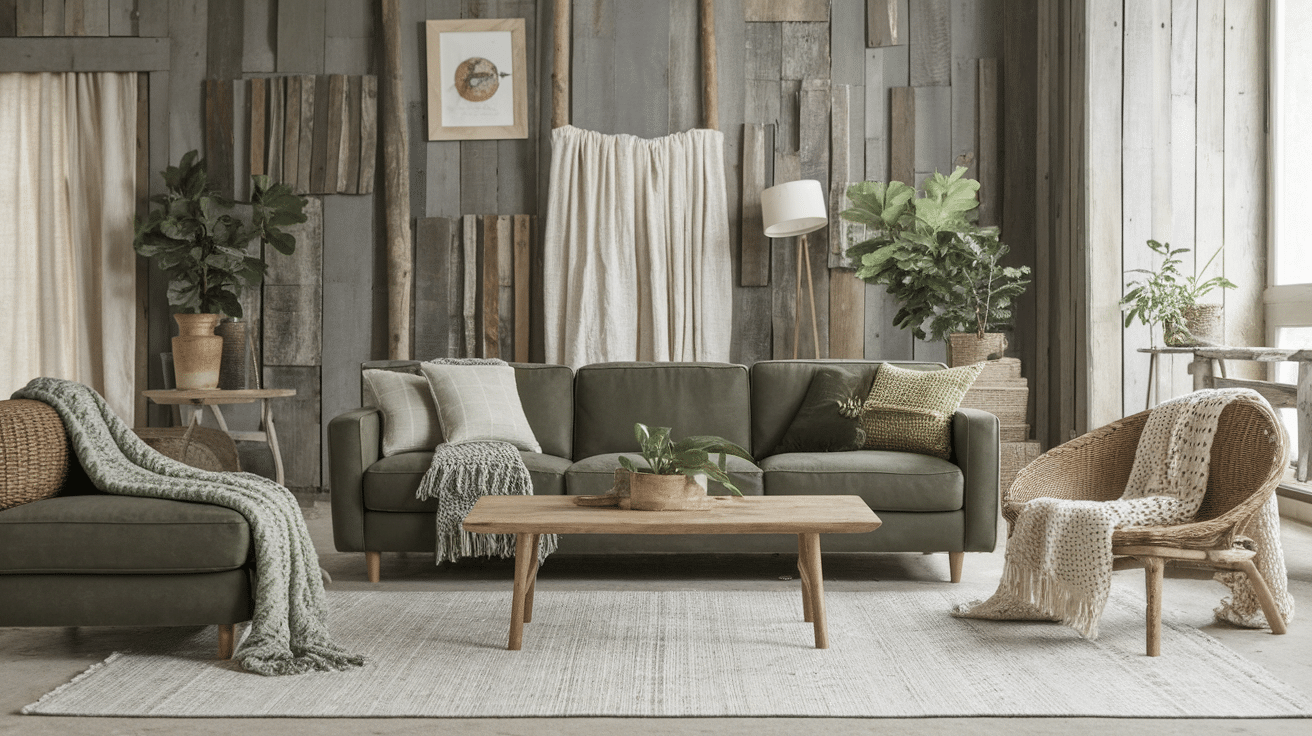Have you ever walked into a room and felt instantly calm? A rustic sage-green living room can do that with its soft, earthy tones, which work in any light.
I’ve spent years helping folks create cozy and fresh spaces. Sage green’s soft, earthy tone brings the outdoors in and works in any light.
A rustic touch adds warmth through natural wood, simple textiles, and honest materials. It’s not about perfect showroom looks. It’s about creating a space where you can truly relax.
In this blog, I’ll share various creative designs for rustic sage-green living rooms that feel both timeless and current. Are you ready to create a space you’ll love coming home to?
Why Choose Sage Green for Your Living Room?
Sage green feels like a breath of fresh air in home design. This soft, gray-green shade brings calm to any space it touches. It works like the plants and trees outside your window – easy on the eyes and good for the soul.
What makes sage green special:
- It doesn’t shout for attention like bright colors
- It shifts slightly with changing light throughout the day
- It works as a neutral while still adding color
- It helps make small rooms feel bigger and airy
Sage green pairs perfectly with rustic items. The color sits comfortably beside wooden beams and stone fireplaces. Sage walls make a worn leather couch or pine table look even better.
This color lasts longer than passing trends. Sage green feels timeless rather than trendy. It has worked in homes for hundreds of years, so you won’t feel the need to change it when next year’s colors arrive.
17 Rustic Ideas Featuring Sage Green
These 17 ideas show how versatile sage green can be in creating a rustic living room. From walls to accessories, each suggestion helps build a space that feels both timeless and fresh.
1. Sage Green Walls
Sage green walls create a calm backdrop that brings nature indoors. This soft, muted color works in any light and makes a room feel both fresh and grounded.
The color pairs perfectly with wood tones and natural textures found in rustic design. It has staying power beyond trends because it connects to the outdoors in a subtle way.
Best For:
- Small rooms that need to feel larger
- North-facing spaces that lack warmth
- Homes where you want a relaxing atmosphere
What to Avoid: Using too dark a green shade, which can make the room feel smaller and darker.
2. Vintage Furniture
Vintage pieces bring character and history to your living room that new items can’t match. Look for wooden tables with patina, chairs with interesting shapes, or cabinets with unique details.
One standout vintage piece can set the tone for the entire room. The worn edges and established feel of older furniture grounds a space and makes it feel lived-in.
Best For:
- Creating a focal point
- Adding warmth to modern spaces
- Bringing in unique shapes and textures
What to Avoid: Filling the room with only old pieces can make it feel like a time capsule rather than a living space.
3. Soft and Cozy Textiles
Textiles add the comfort factor to rustic rooms. Think chunky knit throws, linen cushions, and wool rugs in neutral tones or subtle patterns.
These soft elements balance the hardness of wood and stone in rustic design. They also make the space feel more inviting and warm, especially during colder months.
Best For:
- Making seating areas more inviting
- Adding warmth in winter months
- Bringing in subtle color and pattern
What to Avoid: Shiny, synthetic fabrics that look out of place with natural materials.
4. Natural Materials
Natural materials form the foundation of rustic style. Wood, stone, clay, jute, and cotton all bring a genuine texture that synthetic materials can’t match.
These materials age well, developing character over time rather than simply looking worn out. They connect your space to nature and create a sense of timelessness.
Best For:
- Creating visual interest without busy patterns
- Making a space feel timeless
- Connecting your indoor space to nature
What to Avoid: Mixing too many different wood tones in one space – stick to 2-3 for a cohesive look.
5. Sage Green Accent Wall
An accent wall brings in sage green without committing to a fully green room. This approach works well in open floor plans or for those testing out the color.
The contrast draws the eye and creates a natural focal point. It can highlight architecture or define zones in a larger space while keeping the overall feeling light.
Best For:
- Small rooms where four green walls might feel overwhelming
- Highlighting architectural features
- Defining separate areas in open spaces
What to Avoid: Choosing walls with too many doors or windows – pick one with enough solid space to showcase the color.
6. Incorporating Greenery
Living plants enhance a sage green room by adding varied shades of green and bringing actual nature indoors. They create a direct link to the outdoors while improving air quality.
Even a few small plants make a difference in how the space feels. Mix different leaf shapes and plant sizes for a collected, natural look that evolves with the seasons.
Best For:
- Empty corners or shelves
- Adding life to a static space
- Improving indoor air quality
What to Avoid: Using only fake plants, which miss the living benefits of real greenery.
7. Farmhouse Decor
Farmhouse touches like wooden signs, simple pottery, or metal containers add casual charm to a sage-green room. These humble items bring a sense of history and practicality.
They work well mixed with more refined elements to create balance. For the best effect, look for pieces that feel authentic rather than mass-produced.
Best For:
- Adding points of interest to shelves or tables
- Creating a lived-in, collected feel
- Bringing in personal touches
What to Avoid: Avoid too many bright white or distressed blue pieces, which can fight with the soft green walls.
8. Rustic Art Pieces
The right art ties everything together in a rustic sage-green room. Look for landscapes, botanical prints, or abstract pieces with earthy colors that complement the walls.
Weathered frames or canvas prints without frames work best with the rustic sage theme. Art adds the final layer of personality that makes a room feel complete.
Best For:
- Filling large wall spaces
- Bringing in colors that complement sage green
- Adding personality to the room
What to Avoid: Glossy, modern frames or art with colors that clash with your green and wood palette.
9. Warm Lighting
Lighting transforms how sage green looks and feels in a space. Warm, yellow-toned bulbs enhance the cozy factor and make the green look richer and more inviting.
Multiple light sources at different heights create depth and allow for changing moods. Table lamps, floor lamps, and candles all contribute to the rustic atmosphere.
Best For:
- Creating evening ambiance
- Highlighting textures and materials
- Making the space feel welcoming
What to Avoid: Cool, bluish LED lights that make sage green look flat or gray.
10. Wicker and Rattan Furniture
Wicker and rattan pieces add natural texture without the visual weight of wood. Their light color and airy construction balance heavier elements in a rustic sage room.
Consider chairs, side tables, or even lighting fixtures in these materials. They bring in curved lines that soften the sometimes-rigid feel of rustic wooden furniture.
Best For:
- Breaking up too much wood
- Adding visual lightness
- Bringing in curved lines
What to Avoid: Placing these pieces in high-traffic areas where they’ll wear out quickly.
11. Layered Rugs
Layering rugs adds depth, texture, and comfort underfoot. Start with a large natural fiber rug, then add a smaller patterned or colored rug on top.
This technique instantly makes a space feel more designed and comfortable. It also helps define seating areas within larger rooms.
Best For:
- Defining seating areas
- Adding warmth to wood or tile floors
- Creating visual interest at ground level
What to Avoid: Choosing rugs with busy patterns that compete with each other.
12. Exposed Beams
Wooden beams draw the eye up and add architectural interest to any room. Whether original or added later, they bring an instant rustic character to a space.
Natural or dark-stained wood beams look striking against sage green walls. They add a sense of history and structure even to newer homes.
Best For:
- Rooms with high ceilings
- Spaces that feel too new or flat
- Creating a traditional, timeless look
What to Avoid: Painting beams in colors—natural wood tones work best with sage green.
13. Bohemian Touches
Bohemian elements like macramé wall hangings, floor pillows, or global textiles add a relaxed, collected feel. These pieces bring in subtle patterns and textures.
They soften the sometimes-rigid lines of rustic furniture and add a layer of comfort. Just a few well-chosen items can shift the feel of the entire room.
Best For:
- Adding personality to the space
- Creating a relaxed atmosphere
- Bringing in handmade elements
What to Avoid: Going overboard—a few well-chosen bohemian pieces have more impact than too many.
14. Vintage Lighting Fixtures
Vintage-inspired lights with aged metal, seeded glass, or industrial shapes complement the rustic sage theme perfectly. These fixtures add character while providing the necessary function.
Whether it’s a statement chandelier or simple wall sconces, lighting fixtures can serve as both practical elements and decoration. They set the mood while adding period details.
Best For:
- Creating focal points
- Adding period character
- Establishing the right mood with light quality
What to Avoid: Fixtures that are too small—in rustic spaces, lighting should make a statement.
15. Chalk-Painted Cabinets
Chalk paint gives furniture and cabinets a soft, matte finish that fits perfectly with rustic style. The slightly textured finish hides imperfections and feels less formal than glossy paint.
Sage green or complementary cream tones work beautifully with this painting technique. The finish can be sealed for durability or distressed for an aged look.
Best For:
- Updating old furniture without stripping
- Creating a soft, aged look
- Bringing color to wood-heavy spaces
What to Avoid: Skipping prep work—even chalk paint needs clean surfaces for good results.
16. Rustic Shelving
Open wooden shelves display collections while adding storage without visual weight. Reclaimed wood, pipe brackets, or floating styles all work well with the rustic sage theme.
The key is simplicity—let the items on the shelves provide the interest. Shelves allow you to change your decor seasonally without major overhauls.
Best For:
- Displaying plants, books, or collections
- Making use of wall space
- Breaking up large wall expanses
What to Avoid: Overcrowding—leave some empty space to keep the look intentional.
17. Slipcovered Furniture
Furniture with washable slipcovers in linen or cotton brings practicality to rustic sage rooms. These covers can be removed for cleaning and even changed seasonally.
Their relaxed, slightly rumpled look adds to the comfortable, lived-in feel of rustic design. They’re perfect for real homes where people actually live, not just look.
Best For:
- Homes with kids or pets
- People who like to change looks seasonally
- Creating a casual, comfortable vibe
What to Avoid: White fabrics in high-use areas—opt for oatmeal, beige, or sage tones that hide minor marks.
Conclusion
Creating a rustic sage-green living room brings comfort and timeless style. Natural materials paired with this gentle green create a space that’s both fresh and grounded.
Start with ideas that speak to you most—maybe sage walls or green accents with wood. The best rooms reflect the people who live in them, telling their unique stories.
Try small changes first—a plant, a textured pillow, or a wooden side table. See how these elements feel in your space before making bigger investments.
Your perfect rustic sage-green room will grow naturally over time, just like plants. What elements from this palette will you try first in your own home?
Frequently Asked Questions
What is a Complementary Color to Sage Green?
Complementary to sage green, a muted green with gray undertones, are soft, muted reds or pinks with similar gray tones. Ideal matches include dusty rose, soft terracotta, muted raspberry, warm mauve, and dusty brick red. These tones balance sage green beautifully.
How to Decorate a Rustic Living Room?
Rustic living rooms incorporate natural materials, such as wood, stone, and leather, to create a cozy, nature-inspired space. Choose handcrafted furniture, add wooden beams or stone accents, and use warm lighting. Incorporate plants and stick to earthy tones, such as browns, tans, and greens.

























